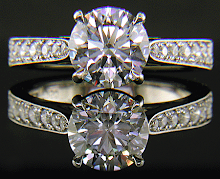While I love designing and creating beautiful jewelry featuring colored gemstones, I also love finding and collecting nature's natural jewels.....mineral specimens.
This is a striking Selenite crystal specimen I found at the Tucson gem and mineral shows a couple of years ago.
Selenite is a form of Gypsum which is a more common mineral species. Gypsum generally forms by the sedimentary process and is often found in large massive beds that have precipitated from waters high in saline content.Selenite is the colorless and transparent variety of Gypsum that also displays a pearly luster. The origin of the word Selenite comes from the Greek word for Moon. And you can certainly see why this mineral was called Moon Rock by early Greeks.....it shimmers like moonlit rippling water on a lake.
Hook shaped selenite crystals like this one are really dramatic in appearance and quite collectible. Minerals specialists call this type of long thin specimen with bends "Ram's Horn Selenite."
You must be careful when handling Selenite as it is a fragile mineral and only has a hardness 2 which means you can scratch it with your fingernail.
More common forms of the mineral gypsum are used in drywall and plaster of paris. Because it is a natural insulator Gypsum, it helps drywall resist fire for a while.







1 comment:
Do not leave selenite in water! You may rinse selenite with water, but if it is submerged in water for an extended period, it will degrade.
Post a Comment